Examining Vegetation Change and Associated Spatial Patterns in Wuyishan National Park at Different Protection Levels
Abstract
1. Introduction
2. Materials and Methods
2.1. Study Area
2.2. Data Preparation
2.3. Vegetation Change Detection Method
2.3.1. The Basic Principles of the Wild Binary Segmentation Method
2.3.2. Vegetation Change Detection and Accuracy Assessment
2.4. Analysis of Vegetation Change Characteristics
2.5. Impact of Vegetation Changes on Spatial Patterns
3. Results
3.1. Accuracy Assessment of Change Detection Results
3.2. Spatial and Temporal Characteristics of Abrupt Vegetation Change
3.3. Spatial and Temporal Patterns of Vegetation Brownness Change under Different Protection Levels
3.4. Contribution of Vegetation Changes to Current Spatial Patterns
4. Discussion
4.1. Vegetation Change Characteristics of Wuyishan National Park
4.2. Influence of Different Drivers on the Current Spatial Characteristics of Vegetation in Wuyishan National Park
5. Conclusions
Author Contributions
Funding
Institutional Review Board Statement
Informed Consent Statement
Acknowledgments
Conflicts of Interest
Appendix A
| Prots | Prot | NP | NPgz | NPys | NPwy | ||||||
|---|---|---|---|---|---|---|---|---|---|---|---|
| Factor | q | Factor | q | Factor | q | Factor | q | Factor | q | Factor | q |
| EVI1986∩TEVI | 0.713 | EVI1986∩TEVI | 0.672 | EVI1986∩TEVI | 0.581 | EVI1986∩TEVI | 0.616 | EVI1986∩TEVI | 0.644 | EVI1986∩TEVI | 0.645 |
| EVI1986∩AEVI | 0.639 | EVI1986∩AEVI | 0.613 | EVI1986∩AEVI | 0.501 | EVI1986∩AEVI | 0.561 | EVI1986∩GEVI | 0.578 | EVI1986∩AEVI | 0.562 |
| EVI1986∩Aspect | 0.636 | EVI1986∩Aspect | 0.580 | EVI1986∩Aspect | 0.438 | EVI1986∩Aspect | 0.514 | EVI1986∩AEVI | 0.571 | EVI1986∩GEVI | 0.495 |
| EVI1986∩GEVI | 0.616 | EVI1986∩GEVI | 0.565 | EVI1986∩GEVI | 0.435 | EVI1986∩GEVI | 0.507 | EVI1986∩DEM | 0.565 | EVI1986∩Aspect | 0.487 |
| EVI1986∩DEM | 0.596 | EVI1986∩Slope | 0.545 | EVI1986∩Slope | 0.428 | EVI1986∩Slope | 0.506 | EVI1986∩Aspect | 0.561 | EVI1986 ∩Slope | 0.483 |
| EVI1986∩Slope | 0.585 | EVI1986∩DEM | 0.537 | EVI1986∩DEM | 0.419 | EVI1986∩DEM | 0.503 | EVI1986∩Slope | 0.517 | EVI1986∩DEM | 0.477 |
| Aspect∩TEVI | 0.421 | Slope∩Aspect | 0.348 | Aspect∩TEVI | 0.290 | Aspect∩TEVI | 0.311 | DEM∩Aspect | 0.365 | Aspect∩TEVI | 0.300 |
| DEM∩Aspect | 0.411 | DEM∩Aspect | 0.343 | Slope∩Aspect | 0.287 | Slope∩Aspect | 0.303 | Slope∩Aspect | 0.347 | Slope∩Aspect | 0.289 |
| Aspect∩AEVI | 0.400 | Aspect∩TEVI | 0.341 | DEM∩Aspect | 0.261 | DEM∩Aspect | 0.274 | Aspect∩TEVI | 0.333 | DEM∩Aspect | 0.274 |
| Slope∩Aspect | 0.399 | Aspect∩AEVI | 0.328 | Aspect∩AEVI | 0.240 | Aspect∩AEVI | 0.249 | Aspect∩AEVI | 0.308 | Aspect∩AEVI | 0.260 |
References
- Chen, C.; Park, T.; Wang, X.; Piao, S.; Xu, B.; Chaturvedi, R.K.; Fuchs, R.; Brovkin, V.; Ciais, P.; Fensholt, R.; et al. China and India lead in greening of the world through land-use management. Nat. Sustain. 2019, 2, 122–129. [Google Scholar] [CrossRef] [PubMed]
- Song, X.P.; Hansen, M.C.; Stehman, S.V.; Potapov, P.V.; Tyukavina, A.; Vermote, E.F.; Townshend, J.R. Global land change from 1982 to 2016. Nature 2018, 560, 639–643. [Google Scholar] [CrossRef] [PubMed]
- Li, D.; Lu, D.; Zhao, Y.; Zhou, M.; Chen, G. Spatial patterns of vegetation coverage change in giant panda habitat based on MODIS time-series observations and local indicators of spatial association. Ecol. Indic. 2021, 124, 107418. [Google Scholar] [CrossRef]
- Long, H.; Liu, Y.; Hou, X.; Li, T.; Li, Y. Effects of land use transitions due to rapid urbanization on ecosystem services: Implications for urban planning in the new developing area of China. Habitat Int. 2014, 44, 536–544. [Google Scholar] [CrossRef]
- Zhang, M.; Lin, H.; Long, X.; Cai, Y. Analyzing the spatiotemporal pattern and driving factors of wetland vegetation changes using 2000–2019 time-series Landsat data. Sci. Total. Environ. 2021, 780, 146615. [Google Scholar] [CrossRef]
- Xu, L.; Yu, G.; Tu, Z.; Zhang, Y.; Tsendbazar, N.E. Monitoring vegetation change and their potential drivers in Yangtze River Basin of China from 1982 to 2015. Environ. Monit. Assess. 2020, 192, 642. [Google Scholar] [CrossRef]
- Wang, J.; Wang, K.; Zhang, M.; Zhang, C. Impacts of climate change and human activities on vegetation cover in hilly southern China. Ecol. Eng. 2015, 81, 451–461. [Google Scholar] [CrossRef]
- Chen, B.; Xiao, X.; Li, X.; Pan, L.; Ma, J.; Dong, J.; Qin, Y.; Zhao, B.; Wu, Z.; Sun, R.; et al. A mangrove forest map of China in 2015: Analysis of time series Landsat 7/8 and Sentinel-1A imagery in Google Earth Engine cloud computing platform. ISPRS J. Photogramm. Remote Sens. 2017, 131, 104–120. [Google Scholar] [CrossRef]
- Coppin, P.; Jonckheere, I.; Nackaerts, K.; Muys, B.; Lambin, E. Digital change detection methods in ecosystem monitoring: A review. Int. J. Remote Sens. 2004, 25, 1565–1596. [Google Scholar] [CrossRef]
- Lu, D.; Mausel, P.; Brondízio, E.S.; Moran, E. Change detection techniques. Int. J. Remote Sens. 2004, 25, 2365–2401. [Google Scholar] [CrossRef]
- Wulder, M.A.; Masek, J.G.; Cohen, W.B.; Loveland, T.R.; Woodcock, C.E. Opening the archive: How free data has enabled the science and monitoring promise of Landsat. Remote Sens. Environ. 2012, 122, 2–10. [Google Scholar] [CrossRef]
- Zhu, Z. Change detection using landsat time series: A review of frequencies, preprocessing, algorithms, and applications. ISPRS J. Photogramm. Remote Sens. 2017, 130, 370–384. [Google Scholar] [CrossRef]
- Huang, C.; Goward, S.N.; Masek, J.G.; Thomas, N.; Zhu, Z.; Vogelmann, J.E. An automated approach for reconstructing recent forest disturbance history using dense Landsat time series stacks. Remote Sens. Environ. 2010, 114, 183–198. [Google Scholar] [CrossRef]
- Kennedy, R.E.; Yang, Z.; Cohen, W.B. Detecting trends in forest disturbance and recovery using yearly Landsat time series: 1. LandTrendr—Temporal segmentation algorithms. Remote Sens. Environ. 2010, 114, 2897–2910. [Google Scholar] [CrossRef]
- Hermosilla, T.; Wulder, M.A.; White, J.C.; Coops, N.C.; Hobart, G.W. An integrated Landsat time series protocol for change detection and generation of annual gap-free surface reflectance composites. Remote Sens. Environ. 2015, 158, 220–234. [Google Scholar] [CrossRef]
- Verbesselt, J.; Hyndman, R.; Newnham, G.; Culvenor, D. Detecting trend and seasonal changes in satellite image time series. Remote Sens. Environ. 2010, 114, 106–115. [Google Scholar] [CrossRef]
- Zhu, Z.; Zhang, J.; Yang, Z.; Aljaddani, A.H.; Cohen, W.B.; Qiu, S.; Zhou, C. Continuous monitoring of land disturbance based on Landsat time series. Remote Sens. Environ. 2020, 238, 111116. [Google Scholar] [CrossRef]
- Fryzlewicz, P. Wild binary segmentation for multiple change-point detection. Ann. Stat. 2014, 42, 2243–2281. [Google Scholar] [CrossRef]
- Yang, Y.; Xu, J.; Hong, Y.; Lv, G. The dynamic of vegetation coverage and its response to climate factors in Inner Mongolia, China. Stoch. Environ. Res. Risk Assess. 2012, 26, 357–373. [Google Scholar] [CrossRef]
- Herrero, H.; Southworth, J.; Muir, C.; Khatami, R.; Bunting, E.; Child, B. An evaluation of vegetation health in and around Southern African National Parks during the 21st century (2000–2016). Appl. Sci. 2020, 10, 2366. [Google Scholar] [CrossRef]
- Gaveau, D.; Wandono, H.; Setiabudi, F. Three decades of deforestation in southwest Sumatra: Have protected areas halted forest loss and logging, and promoted re-growth? Biol. Conserv. 2007, 134, 495–504. [Google Scholar] [CrossRef]
- Senf, C.; Pflugmacher, D.; Hostert, P.; Seidl, R. Using Landsat time series for characterizing forest disturbance dynamics in the coupled human and natural systems of Central Europe. ISPRS J. Photogramm. Remote Sens. 2017, 130, 453–463. [Google Scholar] [CrossRef]
- Linkie, M.; Smith, R.J.; Leader-Williams, N. Mapping and predicting deforestation patterns in the lowlands of Sumatra. Biodivers. Conserv. 2004, 13, 1809–1818. [Google Scholar] [CrossRef]
- Carranza, T.; Balmford, A.; Kapos, V.; Manica, A. Protected area effectiveness in reducing conversion in a rapidly vanishing ecosystem: The Brazilian Cerrado. Conserv. Lett. 2014, 7, 216–223. [Google Scholar] [CrossRef]
- Scharlemann, J.P.W.; Kapos, V.; Campbell, A.; Lysenko, I.; Burgess, N.D.; Hansen, M.C.; Gibbs, H.K.; Dickson, B.; Miles, L. Securing tropical forest carbon: The contribution of protected areas to REDD. Oryx 2010, 44, 352–357. [Google Scholar] [CrossRef][Green Version]
- Elleason, M.; Guan, Z.; Deng, Y.; Jiang, A.; Goodale, E.; Mammides, C. Strictly protected areas are not necessarily more effective than areas in which multiple human uses are permitted. Ambio 2021, 50, 1058–1073. [Google Scholar] [CrossRef]
- Miranda, J.J.; Corral, L.; Blackman, A.; Asner, G.; Lima, E. Effects of protected areas on forest cover change and local communities: Evidence from the Peruvian Amazon. World Dev. 2016, 78, 288–307. [Google Scholar] [CrossRef]
- Wendland, K.J.; Baumann, M.; Lewis, D.J.; Sieber, A.; Radeloff, V.C. Protected area effectiveness in European Russia: A postmatching panel data analysis. Land Econ. 2015, 91, 149–168. [Google Scholar] [CrossRef]
- Coetzee, B.W.T.; Gaston, K.J.; Chown, S.L. Local scale comparisons of biodiversity as a test for global protected area ecological performance: A meta-analysis. PLoS ONE 2014, 9, e105824. [Google Scholar] [CrossRef]
- You, G.; Liu, B.; Zou, C.; Li, H.; McKenzie, S.; He, Y.; Gao, J.; Jia, X.; Arain, M.A.; Wang, S.; et al. Sensitivity of vegetation dynamics to climate variability in a forest-steppe transition ecozone, north-eastern Inner Mongolia, China. Ecol. Indic. 2021, 120, 106833. [Google Scholar] [CrossRef]
- Lamchin, M.; Lee, W.K.; Jeon, S.W.; Wang, S.W.; Lim, C.H.; Song, C.; Sung, M. Long-term trend of and correlation between vegetation greenness and climate variables in Asia based on satellite data. MethodsX 2018, 5, 803–807. [Google Scholar] [CrossRef]
- Duo, A.; Zhao, W.J.; Qu, X.; Jing, R.; Xiong, K. Spatio-temporal variation of vegetation coverage and its response to climate change in North China plain in the last 33 years. Int. J. Appl. Earth Obs. Geoinf. 2016, 53, 103–117. [Google Scholar] [CrossRef]
- Wang, J.; Xu, C. Geodetector: Principle and prospective. Acta Geogr. Sin. 2017, 72, 116–134, (In Chinese with English abstract). [Google Scholar] [CrossRef]
- Meng, X.; Gao, X.; Li, S.; Lei, J. Spatial and temporal characteristics of vegetation NDVI changes and the driving forces in Mongolia during 1982–2015. Remote Sens. 2020, 12, 603. [Google Scholar] [CrossRef]
- Chen, Y.; Huang, D.; Yan, S. Discussions on public welfare, state dominance and scientificity of national park. Sci. Geogr. Sin. 2014, 34, 257–264, (In Chinese with English abstract). [Google Scholar] [CrossRef]
- Lin, S.; Hu, X.; Wu, C.; Hong, W. Temporal-spatial features of vegetation cover in Mount Wuyi National Park. J. Forest Environ. 2020, 40, 347–355, (In Chinese with English abstract). [Google Scholar] [CrossRef]
- Chen, C. Ecological compensation mechanism in Wuyishan National Nature Reserve of Fujian Province, China. Sci. Geogr. Sin. 2011, 31, 594–599, (In Chinese with English abstract). [Google Scholar] [CrossRef]
- Chen, C. The landscape ecological pattern analysis and evaluation of Wuyishan National Nature Reserve. Ecol. Sci. 2015, 34, 142–146, (In Chinese with English abstract). [Google Scholar] [CrossRef]
- Masek, J.G.; Collatz, G.J. Estimating forest carbon fluxes in a disturbed southeastern landscape: Integration of remote sensing, forest inventory, and biogeochemical modeling. J. Geophys. Res. Biogeosci. 2006, 111, 1–15. [Google Scholar] [CrossRef]
- Arvidson, T.; Gasch, J.; Goward, S.N. Landsat 7’s long-term acquisition plan—An innovative approach to building a global imagery archive. Remote Sens. Environ. 2001, 78, 13–26. [Google Scholar] [CrossRef]
- Zhu, Z.; Woodcock, C.E.; Olofsson, P. Continuous monitoring of forest disturbance using all available Landsat imagery. Remote Sens. Environ. 2012, 122, 75–91. [Google Scholar] [CrossRef]
- Karathanassi, V.; Kolokousis, P.; Ioannidou, S. A comparison study on fusion methods using evaluation indicators. Int. J. Remote Sens. 2007, 28, 2309–2341. [Google Scholar] [CrossRef]
- Cohen, W.B.; Yang, Z.; Kennedy, R. Detecting trends in forest disturbance and recovery using yearly Landsat time series: 2. TimeSync—Tools for calibration and validation. Remote Sens. Environ. 2010, 114, 2911–2924. [Google Scholar] [CrossRef]
- Olson, D.L.; Delen, D. Advanced Data Mining Techniques; Springer: Berlin/Heidelberg, Germany, 2008. [Google Scholar] [CrossRef]
- Zhu, Z.; Woodcock, C.E. Continuous change detection and classification of land cover using all available Landsat data. Remote Sens. Environ. 2014, 144, 152–171. [Google Scholar] [CrossRef]
- Zhu, Z.; Fu, Y.; Woodcock, C.E.; Olofsson, P.; Vogelmann, J.E.; Holden, C.; Wang, M.; Dai, S.; Yu, Y. Including land cover change in analysis of greenness trends using all available Landsat 5, 7, and 8 images: A case study from Guangzhou, China (2000–2014). Remote Sens. Environ. 2016, 185, 243–257. [Google Scholar] [CrossRef]
- Li, D.; Lu, D.; Wu, M.; Shao, X.; Wei, J. Examining land cover and greenness dynamics in Hangzhou Bay in 1985–2016 using Landsat time-series data. Remote Sens. 2018, 10, 32. [Google Scholar] [CrossRef]
- Xiao, T. The Significance Test and Effect Analysis of Functional. Master’s Thesis, Zhengzhou University, Zhengzhou, China, 2018. (In Chinese with English abstract). [Google Scholar]
- Zhu, L.; Meng, J.; Zhu, L. Applying Geodetector to disentangle the contributions of natural and anthropogenic factors to NDVI variations in the middle reaches of the Heihe River Basin. Ecol. Indic. 2020, 117, 106545. [Google Scholar] [CrossRef]
- Wei, L.; Lan, S.; Xiong, H.; Shen, Q.; Lu, D.; Chen, X. Habitat quality evaluation of Wuyi Mountain National Nature Reserve in 1988−2018 based on remote sensing data. J. Southwest For. Univ. 2021, 41, 1–11, (In Chinese with English abstract). [Google Scholar] [CrossRef]
- Françoso, R.D.; Brandão, R.; Nogueira, C.C.; Salmona, Y.B.; Machado, R.B.; Colli, G.R. Habitat loss and the effectiveness of protected areas in the Cerrado Biodiversity Hotspot. Nat. Conserv. 2015, 13, 35–40. [Google Scholar] [CrossRef]
- Porter-Bolland, L.; Ellis, E.; Guariguata, M.R.; Ruiz-Mallén, I.; Negrete-Yankelevich, S.; Reyes-García, V. Community managed forests and forest protected areas: An assessment of their conservation effectiveness across the tropics. For. Ecol. Manag. 2012, 268, 6–17. [Google Scholar] [CrossRef]
- Li, L.; Xiao, G. Analysis on the change of ecological environmental quality in Wuyishan National Park based on RESI. Fujian Agric. Sci. Technol. 2021, 52, 63–70, (In Chinese with English abstract). [Google Scholar] [CrossRef]
- Liu, S.; Ding, J.; Xu, H.; Wang, J.; Xu, Z.; Ruan, H. Effects of snow storm on soil available nitrogen in evergreen broad leaf forest in Wuyi Mountain. J. Nanjing For. Univ. 2010, 34, 126–130, (In Chinese with English abstract). [Google Scholar] [CrossRef]
- Okutomi, K.; Shinoda, S.; Fukuda, H. Causal analysis of the invasion of broad-leaved forest by bamboo in Japan. J. Veg. Sci. 1996, 7, 723–728. [Google Scholar] [CrossRef]
- Li, L.; Zhou, G. Response of forest vegetation to scenic activities in Wuyishan National Park. Acta Ecol.Sin. 2020, 40, 7267–7276, (In Chinese with English abstract). [Google Scholar] [CrossRef]
- Xu, X.; Guan, C.; Lan, S. Species composition and diversity of trees in a subtropical evergreen broad-leaved forest in Wuyi Mountain: 2002–2015. Mol. Plant Breed. 2021, 1–9, (In Chinese with English abstract). [Google Scholar]
- Hartter, J.; Goldman, A. Local responses to a forest park in western Uganda: Alternate narratives on fortress conservation. Oryx 2011, 45, 60–68. [Google Scholar] [CrossRef]
- Shen, Q.; Gao, G.; Han, F.; Xiao, F.; Ma, Y.; Wang, S.; Fu, B. Quantifying the effects of human activities and climate variability on vegetation cover change in a hyper-arid endorheic basin. Land Degrad. Dev. 2018, 29, 3294–3304. [Google Scholar] [CrossRef]
- Huo, H.; Sun, C. Spatiotemporal variation and influencing factors of vegetation dynamics based on Geodetector: A case study of the northwestern Yunnan Plateau, China. Ecol. Indic. 2021, 130, 108005. [Google Scholar] [CrossRef]
- Zhou, M.; Li, D.; Zou, J. Vegetation change of giant panda habitats in Qionglai Mountains through dense Landsat Data. Chin. J. Plant Ecol. 2021, 45, 355–369, (In Chinese with English abstract). [Google Scholar] [CrossRef]
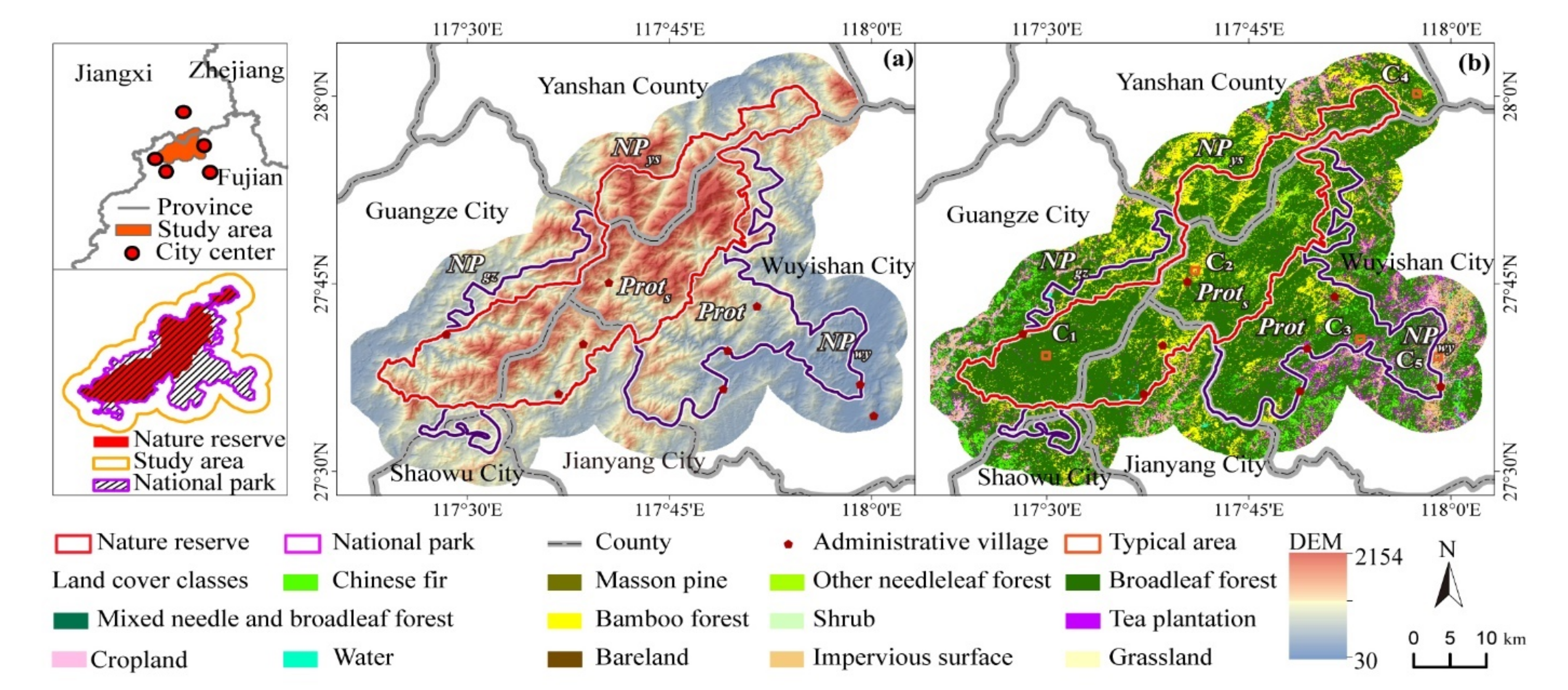
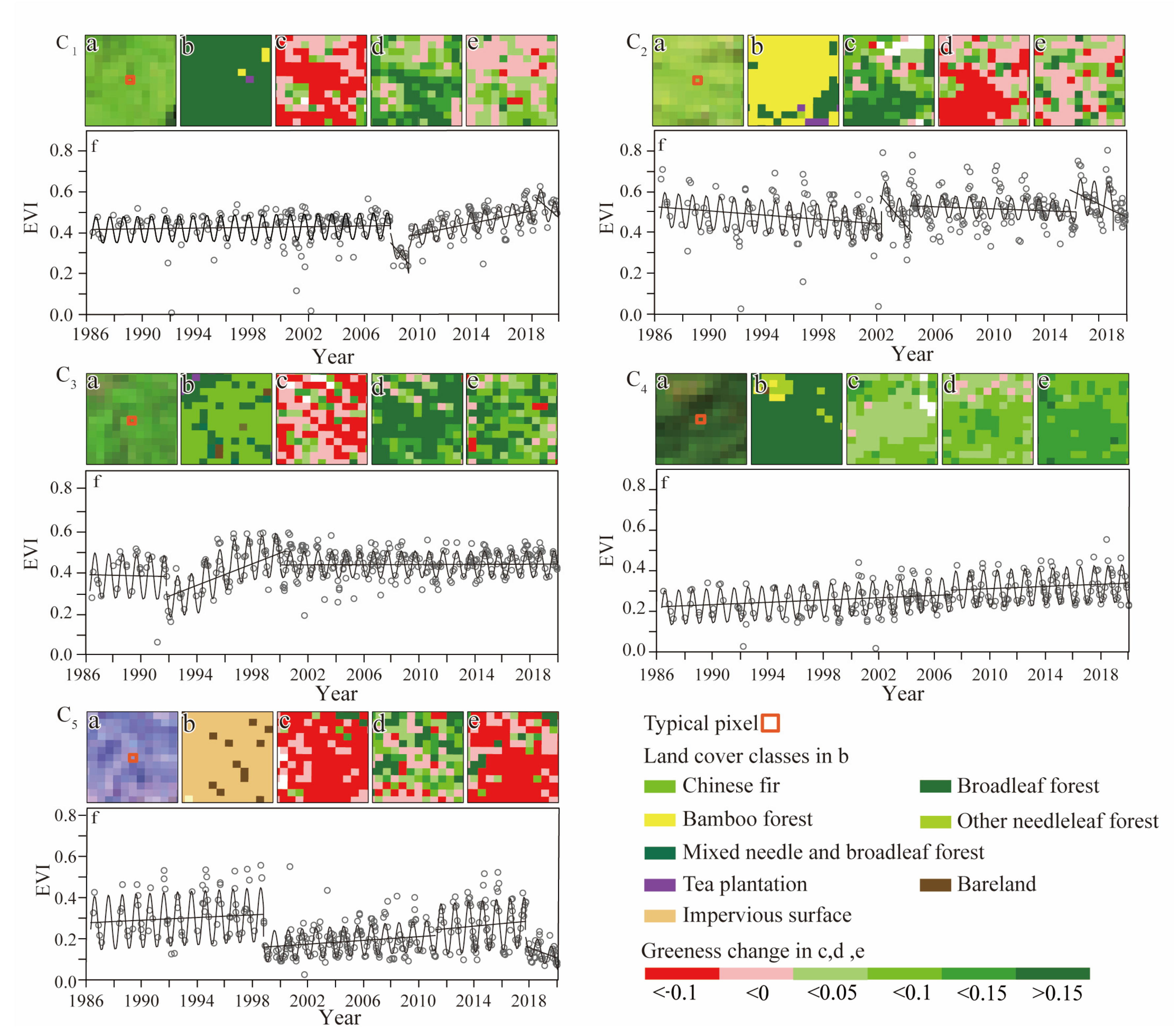
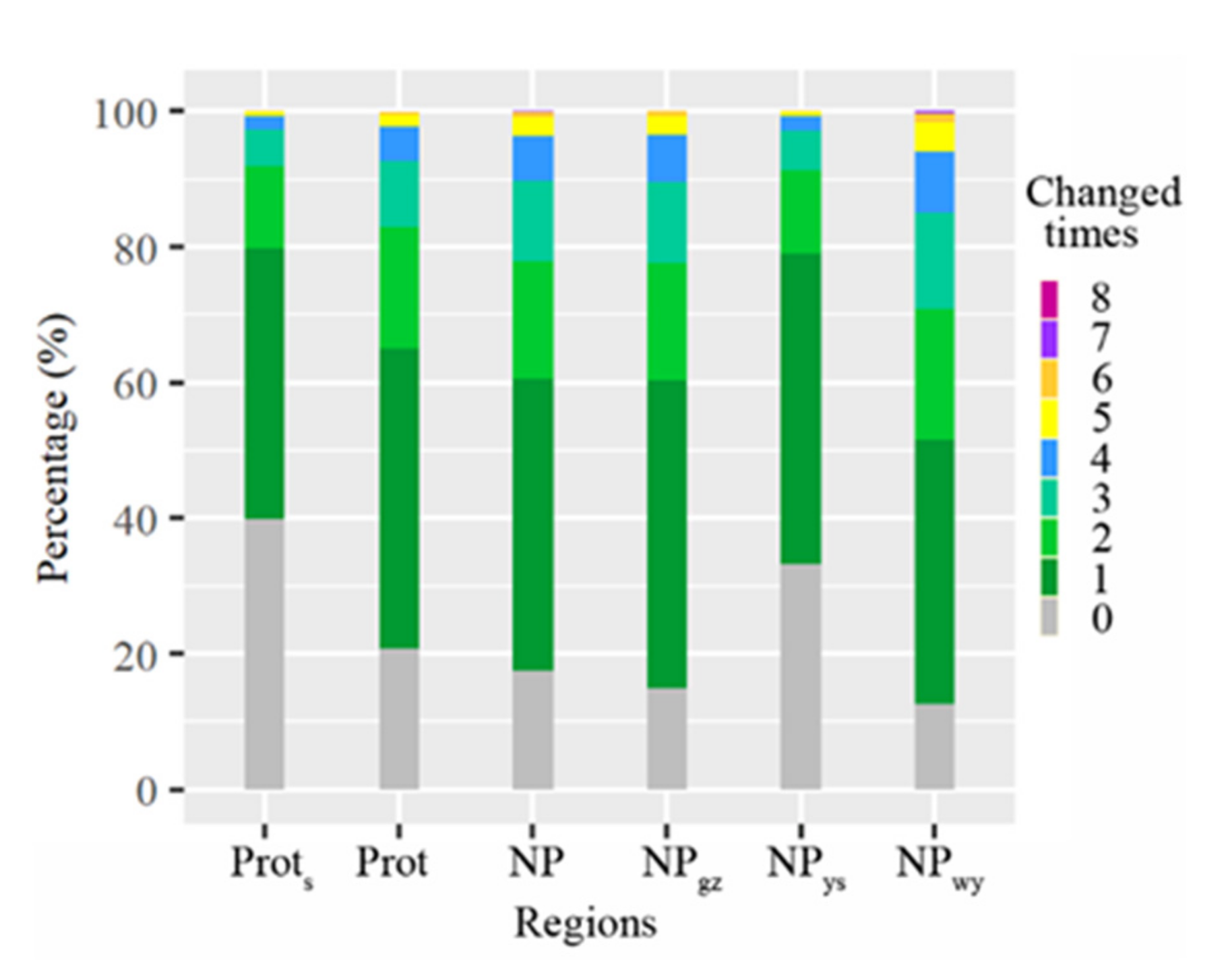
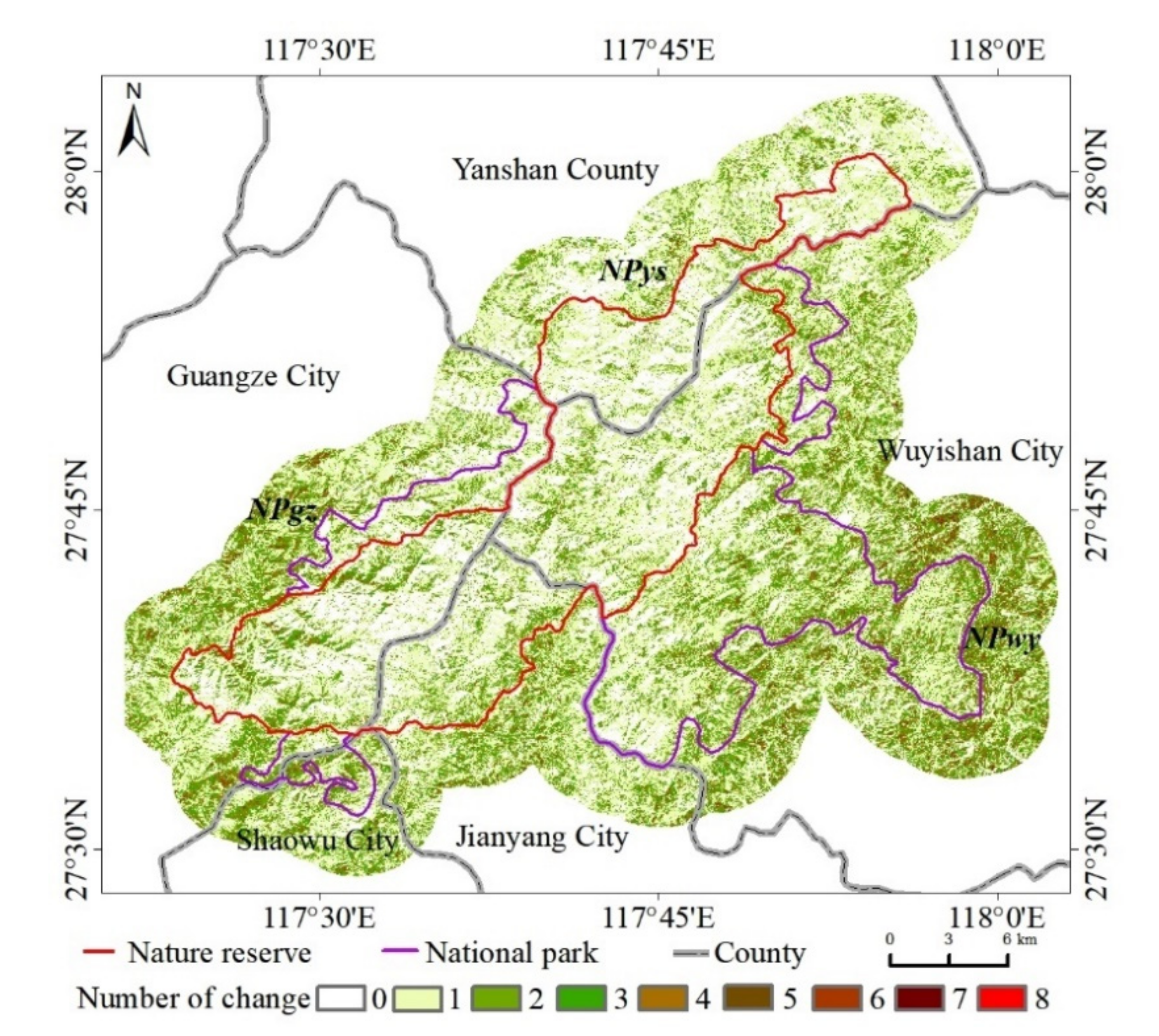
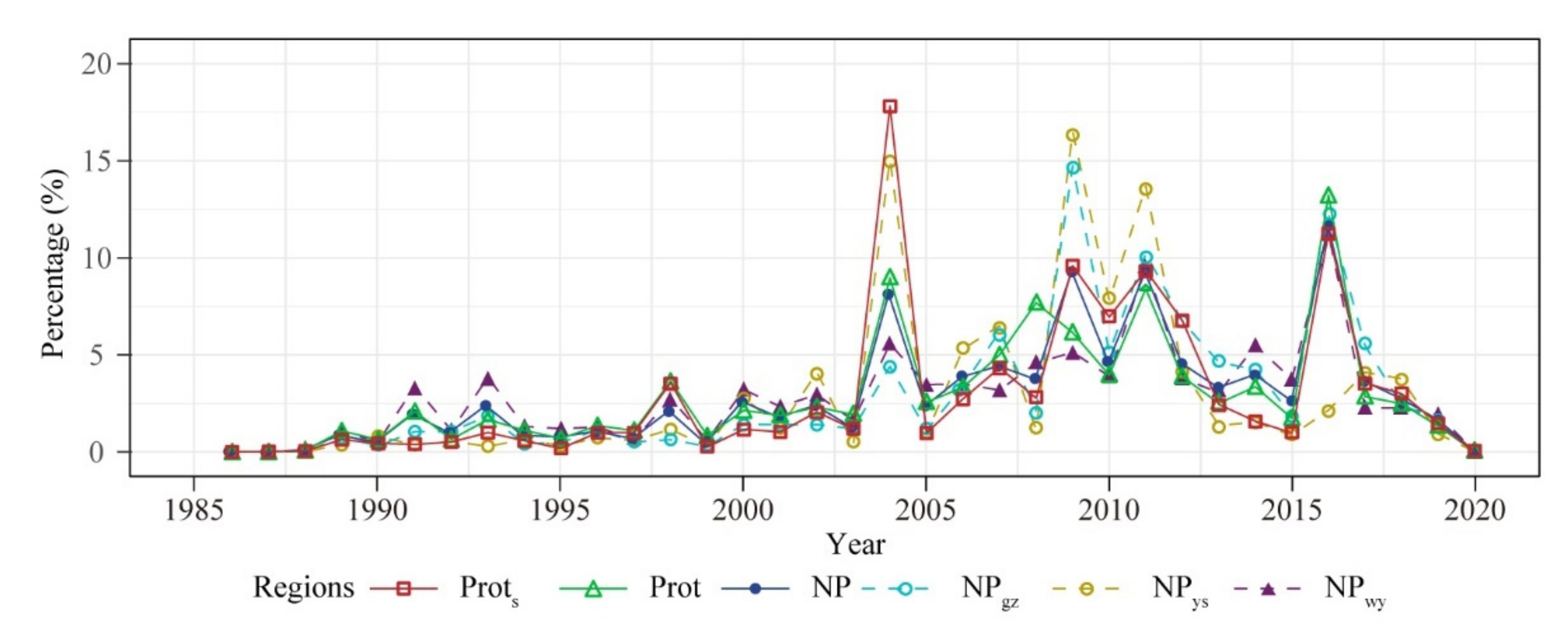
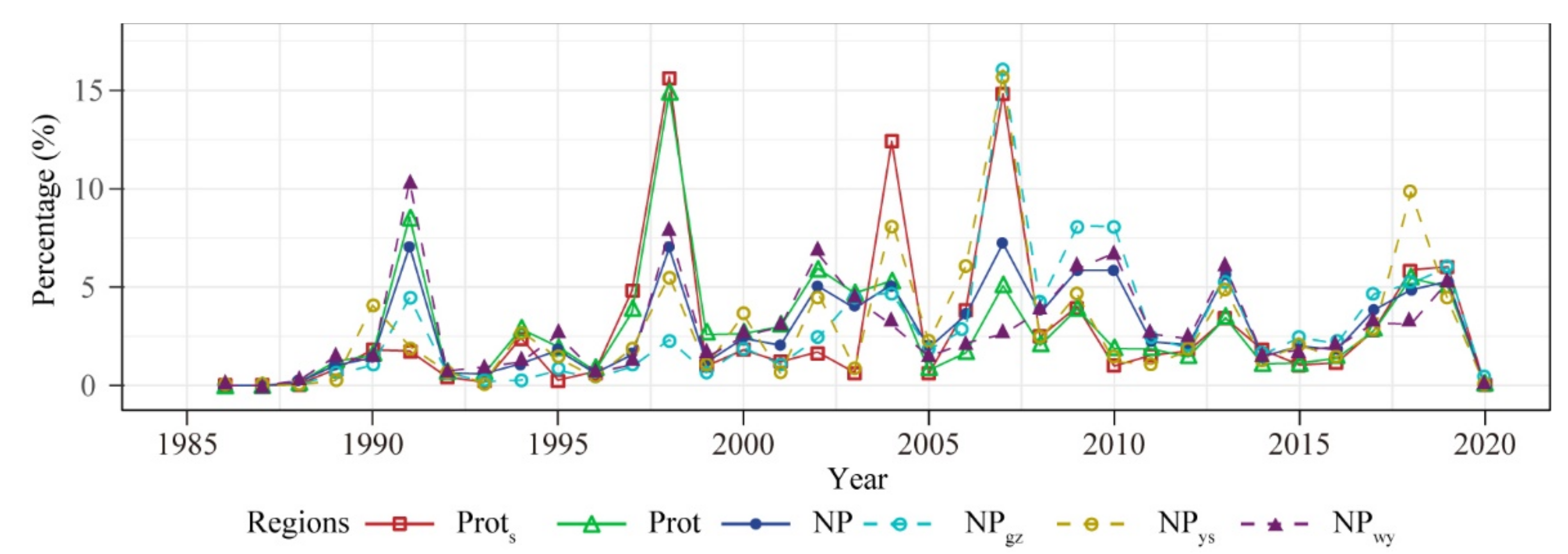

| Rules | Interaction Effects |
|---|---|
| q(X1∩X2) < Min(q(X1),q(X2)) | Weak, nonlinear |
| Min(q(X1),q(X2) < q(X1∩X2) < Max(q(x1),q(X2)) | Weak, unilinear |
| q(X1∩X2) > Max(q(X1),q(X2)) | Enhanced, bilinear |
| q(X1∩X2) = q(X1)+q(X2) | Independent |
| q(X1∩X2)>q(X1)+q(X2) | Enhanced, nonlinear |
| Grade | EVI1986 | DEM (m) | Slope (°) | Aspect | AEVI | GEVI | TEVI |
|---|---|---|---|---|---|---|---|
| 1 | <0.20 | <386 | <5 | North | <−0.08 | <−0.11 | <−0.08 |
| 2 | 0.20–0.27 | 386–594 | 5–15 | Northeast | 0 | 0 | 0 |
| 3 | 0.27–0.32 | 594–806 | 15–25 | East | 0–0.02 | 0–0.01 | 0–0.04 |
| 4 | 0.32–0.38 | 806–1027 | 25–35 | Southeast | 0.02–0.05 | 0.01–0.04 | 0.04–0.07 |
| 5 | 0.38–0.43 | 1027–1266 | 35–45 | South | 0.05–0.08 | 0.04–0.08 | 0.07–0.11 |
| 6 | 0.43–0.49 | 1266–1546 | >45 | Southwest | 0.08–0.18 | 0.08–0.19 | 0.11–0.23 |
| 7 | 0.49–0.68 | >1546 | West | >0.18 | >0.19 | >0.23 | |
| 8 | Northwest |
| Reference Data | Percentage of Correctly Detected Change Year | ||||
|---|---|---|---|---|---|
| Stable Samples | Changed Samples | Producer’s Accuracy | In the Same Year | Within One Year (±1) | |
| Stable samples | 112 | 30 | 78.87% | ||
| Changed samples | 38 | 220 | 85.27% | 60% | 76% |
| User’s Accuracy | 74.67% | 88% | Overall Accuracy 83% | ||
| Regions | Prots | Prot | NP | NPgz | NPys | NPwy |
|---|---|---|---|---|---|---|
| Prots | - | - | - | - | - | - |
| Prot | YY | - | - | - | - | - |
| NP | YY | YY | - | - | - | - |
| NPgz | YY | N | YY | - | - | - |
| NPys | YY | Y | YY | N | - | - |
| NPwy | YY | N | N | N | YY | - |
| AEVI | GEVI | TEVI | |||||||
|---|---|---|---|---|---|---|---|---|---|
| Regions | Negative (%) | Mean | Std. | Negative (%) | Mean | Std. | Negative (%) | Mean | Std. |
| Prots | 14.26 | 0.035 | 0.563 | 20.97 | 0.034 | 0.212 | 9.57 | 0.055 | 0.374 |
| Prot | 15.75 | 0.049 | 0.270 | 20.93 | 0.040 | 0.498 | 8.29 | 0.079 | 0.422 |
| NP | 19.19 | 0.047 | 0.665 | 23.63 | 0.050 | 0.839 | 11.56 | 0.089 | 0.754 |
| NPgz | 15.54 | 0.054 | 1.269 | 20.99 | 0.057 | 1.150 | 8.34 | 0.104 | 1.022 |
| NPys | 13.47 | 0.056 | 0.304 | 16.25 | 0.056 | 0.640 | 7.95 | 0.094 | 0.591 |
| NPwy | 27.08 | 0.029 | 0.333 | 24.56 | 0.055 | 0.834 | 16.10 | 0.080 | 0.754 |
| Regions | Prots | Prot | NP | NPgz | NPys | NPwy |
|---|---|---|---|---|---|---|
| Prots | - | - | - | - | - | - |
| Prot | YY | - | - | - | - | - |
| NP | YY | YY | - | - | - | - |
| NPgz | YY | N | YY | - | - | - |
| NPys | YY | YY | YY | N | - | - |
| NPwy | YY | N | N | YY | YY | - |
| Prots | Prot | NP | NPgz | NPys | NPwy | |||||||
|---|---|---|---|---|---|---|---|---|---|---|---|---|
| Factor | q | Sort | q | Sort | q | Sort | q | Sort | q | Sort | q | Sort |
| EVI1986 | 0.573 | 1 | 0.530 | 1 | 0.410 | 1 | 0.488 | 1 | 0.508 | 1 | 0.453 | 1 |
| DEM | 0.048 | 3 | 0.056 | 4 | 0.083 | 5 | 0.065 | 5 | 0.081 | 3 | 0.078 | 4 |
| Slope | 0.006 | 7 | 0.025 | 6 | 0.087 | 4 | 0.060 | 6 | 0.051 | 4 | 0.077 | 5 |
| Aspect | 0.354 | 2 | 0.281 | 2 | 0.157 | 2 | 0.181 | 2 | 0.26 | 2 | 0.183 | 2 |
| AEVI | 0.039 | 4 | 0.060 | 3 | 0.076 | 6 | 0.067 | 4 | 0.031 | 6 | 0.075 | 6 |
| GEVI | 0.010 | 6 | 0.013 | 7 | <0.010 | 7 | <0.010 | 7 | <0.010 | 7 | <0.010 | 7 |
| TEVI | 0.038 | 5 | 0.046 | 5 | 0.109 | 3 | 0.102 | 3 | 0.048 | 5 | 0.097 | 3 |
Publisher’s Note: MDPI stays neutral with regard to jurisdictional claims in published maps and institutional affiliations. |
© 2022 by the authors. Licensee MDPI, Basel, Switzerland. This article is an open access article distributed under the terms and conditions of the Creative Commons Attribution (CC BY) license (https://creativecommons.org/licenses/by/4.0/).
Share and Cite
Fan, M.; Liao, K.; Lu, D.; Li, D. Examining Vegetation Change and Associated Spatial Patterns in Wuyishan National Park at Different Protection Levels. Remote Sens. 2022, 14, 1712. https://doi.org/10.3390/rs14071712
Fan M, Liao K, Lu D, Li D. Examining Vegetation Change and Associated Spatial Patterns in Wuyishan National Park at Different Protection Levels. Remote Sensing. 2022; 14(7):1712. https://doi.org/10.3390/rs14071712
Chicago/Turabian StyleFan, Mengzhuo, Kuo Liao, Dengsheng Lu, and Dengqiu Li. 2022. "Examining Vegetation Change and Associated Spatial Patterns in Wuyishan National Park at Different Protection Levels" Remote Sensing 14, no. 7: 1712. https://doi.org/10.3390/rs14071712
APA StyleFan, M., Liao, K., Lu, D., & Li, D. (2022). Examining Vegetation Change and Associated Spatial Patterns in Wuyishan National Park at Different Protection Levels. Remote Sensing, 14(7), 1712. https://doi.org/10.3390/rs14071712







